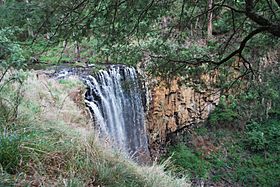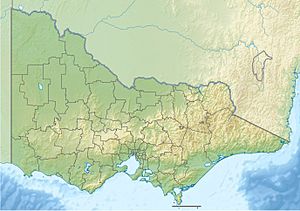Coliban River facts for kids
Quick facts for kids Coliban |
|
|---|---|

Trentham Falls, in the upper reaches of the Coliban River
|
|
| Native name | Teeranyap, Pe-er, Dindelong yaluk |
| Country | Australia |
| State | Victoria |
| Region | Riverina bioregion (IBRA), Central Highlands |
| Local government areas | Moorabool, Hepburn, Mount Alexander, City of Greater Bendigo |
| Towns | Trentham, Malmsbury, Metcalfe, Redesdale, Mintaro |
| Physical characteristics | |
| Main source | Great Dividing Range below Little Hampton 701 m (2,300 ft) 37°25′13″S 144°28′38″E / 37.42028°S 144.47722°E |
| River mouth | confluence with the Campaspe River Lake Eppalock 183 m (600 ft) 36°55′39.5″S 144°32′49.8″E / 36.927639°S 144.547167°E |
| Length | 89 km (55 mi) |
| Basin features | |
| River system | Victorian north–central catchment, Murray-Darling basin |
| Tributaries |
|
| Waterfalls | Trentham Falls |
The Coliban River is a river in Victoria, Australia. It's a perennial river, meaning it flows all year round. The river is part of the larger Murray-Darling Basin, which is a huge river system in Australia.
The Coliban River starts in the Great Dividing Range. It then flows north until it joins the Campaspe River in Lake Eppalock. This river is super important because it provides water for many towns and cities in the area.
Contents
Where is the Coliban River Located?
The Coliban River begins near a place called Little Hampton, close to Lyonville. This area is part of the Great Dividing Range, a long mountain range in Australia. As the river flows, it goes north.
One cool spot along the river is Trentham Falls, where the water drops about 33 metres (108 ft)! After the falls, the river continues its journey. It flows into three important reservoirs: Upper Coliban, Lauriston, and Malmsbury. These reservoirs help store water for people to use.
The river then passes through several towns. These include Malmsbury, Metcalfe, Redesdale, and Mintaro. Finally, the Coliban River meets the Campaspe River inside Lake Eppalock. Over its 89-kilometre (55 mi) journey, the river drops a total of 518 metres (1,699 ft) in elevation.
How Does the Coliban River Help People?
Back in 1858, Gold was discovered in the Coliban River! This led to a lot of people moving to the area. Water from the river became very important for the gold mining towns of Bendigo and Castlemaine.
As these towns grew, they needed more water. So, engineers built a huge water supply system. It included 70 kilometres (43 mi) of tunnels and aqueducts. Aqueducts are like bridges or channels that carry water over long distances.
Over time, this water system was expanded. It started supplying drinking water to Kyneton and many other smaller towns. Today, the Coliban River system provides clean drinking water to over 200,000 people! A company called Coliban Water manages the three main reservoirs that are part of this system.
What Animals and Plants Live in the Coliban River?
The Coliban River is a home for many different animals and plants. One of the most famous animals found here is the platypus. These unique creatures are mammals that lay eggs and have a bill like a duck.
The river also has eight different types of native fish. Sadly, four of these fish species are endangered. This means their numbers are very low, and they are at risk of disappearing. The trout cod is one of these fish. It's considered critically endangered in the river, and it might not even be there anymore.
When it comes to plants, the area around the river used to have a lot of black gum trees (Eucalyptus aggregata). However, many of these trees have been cleared over the years. This has made them quite rare now. Protecting these plants and animals is important for the health of the river.
What Does the Name "Coliban" Mean?
The name "Coliban" comes from the languages of the Indigenous people who lived in this area for thousands of years.
In the Djadjawurrung language, one name for the river is Teeranyap. The meaning of this name isn't fully known today.
In the Daungwurrung and Djadjawurrung languages, another name for the river is Pe-er. Again, its meaning isn't clearly defined.
There's also the name Dindelong yaluk. In this name, yaluk means "river." So, it's like saying "Dindelong River." These names show the deep connection Indigenous people have with the land and its waterways.


